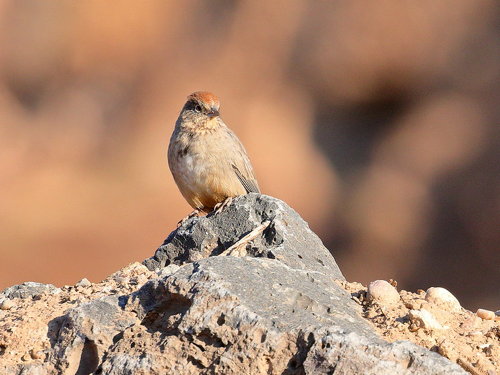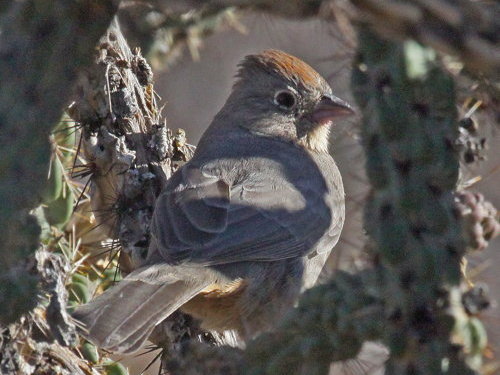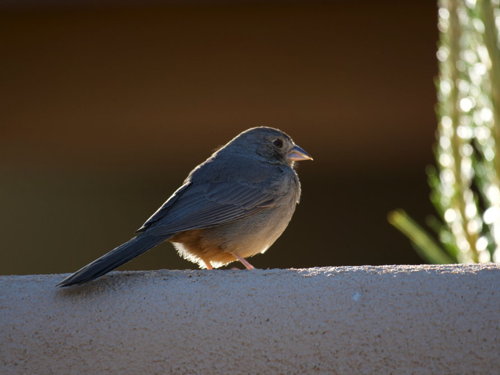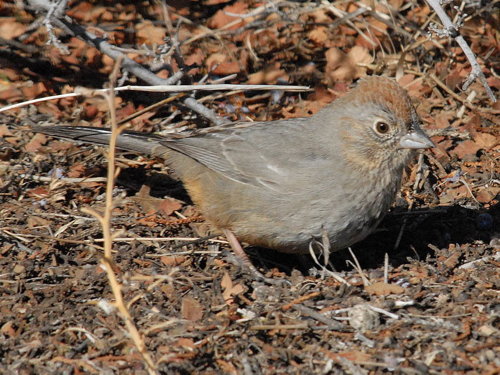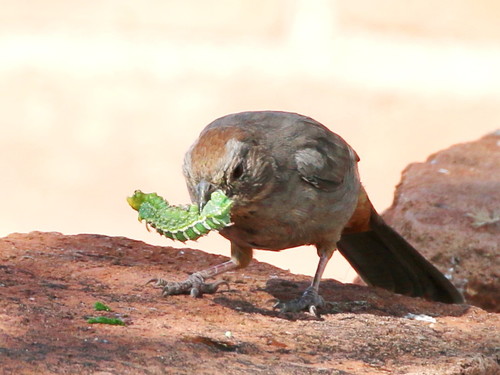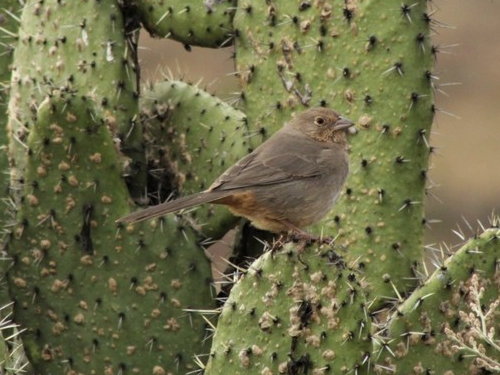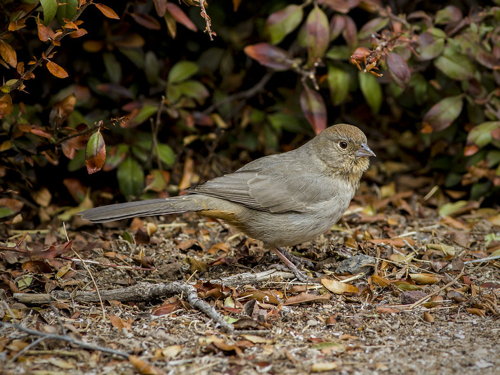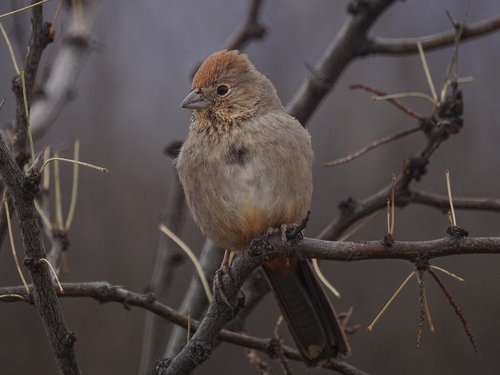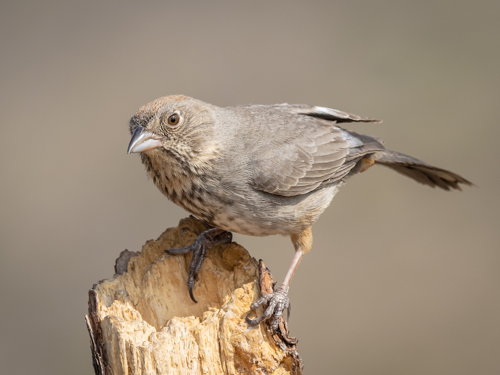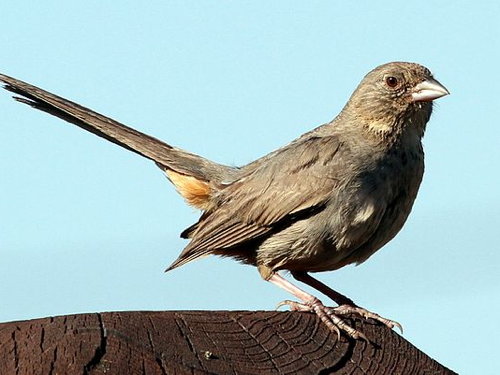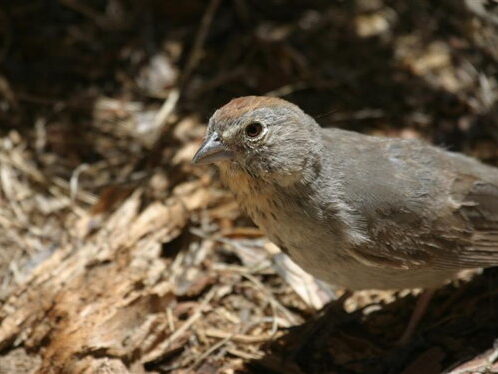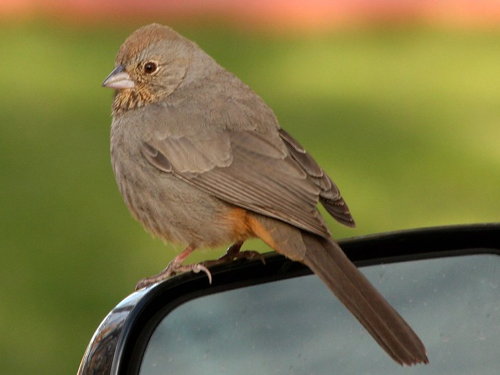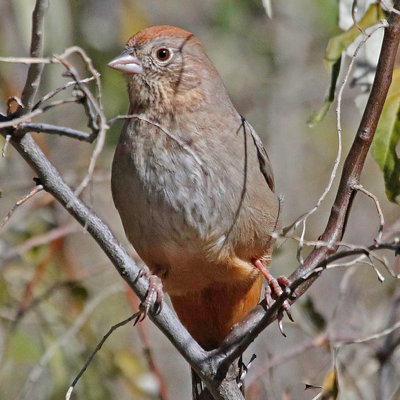Canyon Towhee
Scientific Name: Melozone fusca
Type: Bird
Family: Passerellidae (New World Passerines)
Size: 8.3 to 9.3 inches long; 11-inch wingspan
Weight: 1.3 to 2.3 ounces
Life Span: up to 12 years
Physical Description
Canyon towhees are large sparrows that are often seen in urban areas. Adults of both sexes are an earthy brown color on top with lighter, potentially grayish, underparts and a reddish area under the tail. Their heads can be a bit darker, and this bird’s distinguishing feature is a rufous cap. Canyon towhees have long tails, chunky bodies, and short rounded wings. Once juveniles are fully feathered, they have bobbed tails and brown coats with dotted chests.
Juvenile

Range and Habitat
Canyon towhees inhibit areas of the southwestern US southward into central Mexico. These birds are year-round residents throughout their range, though they may move up and downhill to find warmer or cooler habitats depending on the weather.
These sparrows are usually found on or near the ground in arroyos, desert grasslands, pinyon-juniper-oak woodland, and pine-oak. They will also frequent suburban areas.
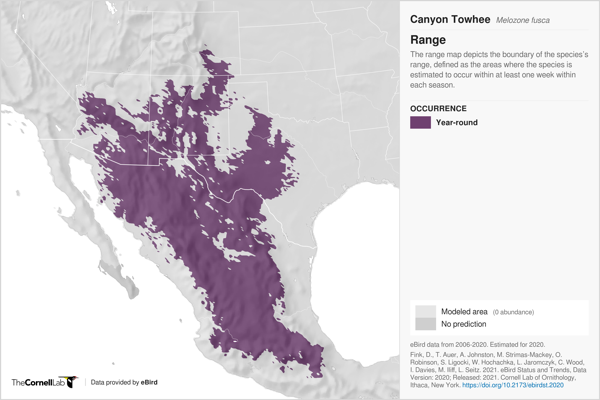
Diet
Canyon towhees consume mostly small seeds and insects that are found on the ground. Seeds predominate in winter with more insects in summer. Young birds are fed mostly on insects. Canyon Towhees will come to platform feeders or seed spread on the ground for millet, sunflower seed, and rolled oats.
Behavior and Social Life
Canyon towhees stay close to the ground. They usually move around by hopping on the ground. However, if fleeing from danger they will make a series of short flights, stopping occasionally on elevated spots.
Canyon towhees use a double-scratch method when looking for food. This consists of a quick jump forward and an even quicker jump back, scratching with the feet to overturn leaves and expose food items. It should be noted, though, that canyon towhees exhibit this behavior to a lesser extent than other towhees. They are often seen foraging under things like logs, bushes, or parked cars. Canyon towhees typically forage alone or as a pair. They do not vigorously defend a territory and often tolerate other canyon towhees in the area.
Foraging
Singing
Life Cycle
An unmated male will sing when announcing that he is ready to be paired during the breeding season. This call is loud, prolonged, and usually heard at dawn, but on occasion during the day. A female will approach a male while fluttering her wings and raising her tail, indicating that she is ready to mate. Females will also make high-pitched vocal sounds and approach males with nesting material with their bills. Canyon towhees are monogamous and form pair bonds that can last a lifetime.
The female builds a bulky nest of grass and plant stems lined with fine grasses and other odd bits of scrap. There may even be flowers incorporated into the nest. Nests are usually placed in trees or shrubs supported by a strong branch at a height of 3 to 12 feet.
A typical clutch is 2 to 6 eggs. The eggs are incubated solely by the female. However, both parents feed the young. The chicks may climb about in bushes while waiting to be fed even before they are ready to fly.
Courting Display
Nest and Eggs
Feeding Young
Title
Ecological Role
Canyon towhees are prey animals for several species of mammals, reptiles, and birds and they are key in maintaining the food chain for these species. In addition, canyon towhees are highly susceptible to parasitism by the brown-headed cowbird.
Interactions With Humans
There are not any documented positive or negative effects of canyon towhees on humans. However, the scratching hop that they do when in dry leaves searching for bugs does provide a source of amusement for most individuals.
Interesting Facts
- Canyon towhees can nest twice a year, timing breeding with seasonal rains when food is more plentiful.
- The usual canyon towhee song usually sounds like ‘chili-chili-chili’ and consists of up to eight syllables which are two-parted.
- The canyon towhee mating call is a woodpecker-like, nasal kyerr.
- The canyon and California towhees were once considered to be a single species known as the brown towhee.
- The split in the canyon and California towhees was based upon analysis of mitochondrial DNA.
- Canyon towhees usually do not fly long distances and are known to take only slow and short flights.
- Some of the common seeds the canyon towhees eat are sorrel, lupine, grass, and pigweed.
- Canyon towhees will eat invertebrates like snails, spiders, and millipedes in addition to a variety of insects.
- The Canyon towhee often feeds on insects on the grills of cars and will hide under the cars when disturbed.
- A group of towhees are known as a “tangle” or a “teapot”.

